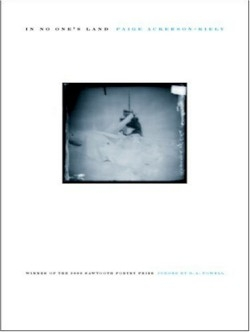In No One's Land
“From / the farm you wrote: when I used to live in the Mountains. / Used is one word that makes me tired. It is almost like lying / down,” writes the author. In her verse, Ackerson-Kiely demonstrates, as in her poem “On the Gentle Nature of Swales,” a profound sense of understanding of the intimate details of the everyday, offset by a sense of both worldliness and hurt, dominated by action through emotion, as well as possession (however reluctant). Although these things can be found in many collections of verse, Ackerson-Kiely’s demonstration of craft is made more interesting by her tendency towards the double narrative; creating stories, often seemingly tangential at the onset, within stories. In “Leave the Job That Is No Lover,” the speaker advises the worker, “When your shift / is done go home alone. After you lock up, pause to touch the door / like it is someone’s wife. Say, he never stopped loving you.” The delight comes not only from the credibility of the speaker, but the impetus for such advice, furthered by the unusual imagery and double narrative.
Ackerson-Kiely, winner of the 2006 Sawtooth Poetry Prize, delivers to the reader an attitude translated by smaller journeys and moments, implying a past worth more than the telling, a past worth living both through and beyond. Sometimes this is demonstrated in a line as simple as “It is true I am afraid of the stranger in men,” from her poem, “To the Understudy”; at other times, the sentiment is more complex, riddled into the precious by her use of imagery to create a second world within the poem, as in “Foucault’s Bed”: “The bed is where you work, castigated, is not like / two mares staring down the girder of their noses. … Crawl or jump in, death just makes the other saddest. Woe. Like / what you would say to horses if you ever wanted them to stop.”
More often than not, the speakers Ackerson-Kiely creates are mixed breeds, containing the hurt and street-smarts of the city and the rare toughness of the wild, the need to survive despite a permanent, and often emotional, injury. Such works are most potent in non-lineated form, though this collection contains lineated pieces as well. Navigating through Ackerson-Kiely’s world seems more appropriate when lines rush wildly together as prose, constantly pushing the reader’s eye forward to the next word or revelation. Her rough images convey not only the texture of the wild landscapes normally associated with frontiersmen, but the lives that must be lived in such a world, and the personal texturing that takes place behind the doors of the self, in small rooms of memory, the door ajar and beckoning the reader to peek in, with some risk, to look upon the larger sentiments that make new again the smallest actions. Such is the world of In No One’s Land, a place where home is both discovered, left behind, and returned to, where the reader may understand the amorphous titles not at face value, but the deeply emotional undercurrent which makes them resonate far after the first read.
Disclosure: This article is not an endorsement, but a review. The publisher of this book provided free copies of the book to have their book reviewed by a professional reviewer. No fee was paid by the publisher for this review. Foreword Reviews only recommends books that we love. Foreword Magazine, Inc. is disclosing this in accordance with the Federal Trade Commission’s 16 CFR, Part 255.

